RENAULT TWINGO 2009 2.G Air Conditioning Manual Online
Manufacturer: RENAULT, Model Year: 2009, Model line: TWINGO, Model: RENAULT TWINGO 2009 2.GPages: 122
Page 81 of 122
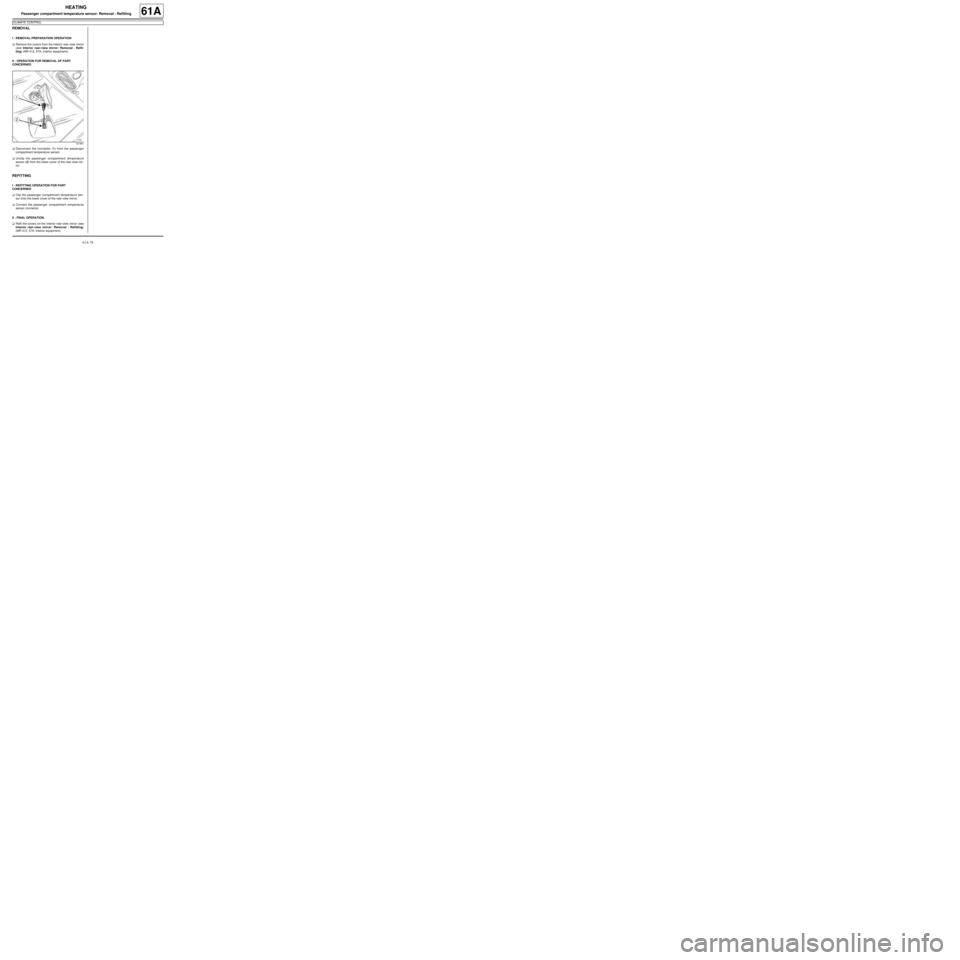
61A-78
HEATING
Passenger compartment temperature sensor: Removal - Refitting
CLIMATE CONTROL
61A
REMOVAL
I - REMOVAL PREPARATION OPERATION
aRemove the covers from the interior rear-view mirror
(see Interior rear-view mirror: Removal - Refit-
ting) (MR 412, 57A, Interior equipment).
II - OPERATION FOR REMOVAL OF PART
CONCERNED
aDisconnect the connector (1) from the passenger
compartment temperature sensor.
aUnclip the passenger compartment temperature
sensor (2) from the lower cover of the rear-view mir-
ror.
REFITTING
I - REFITTING OPERATION FOR PART
CONCERNED
aClip the passenger compartment temperature sen-
sor onto the lower cover of the rear-view mirror.
aConnect the passenger compartment temperature
sensor connector.
II - FINAL OPERATION.
aRefit the covers on the interior rear-view mirror (see
Interior rear-view mirror: Removal - Refitting)
(MR 412, 57A, Interior equipment).
121467
Page 82 of 122
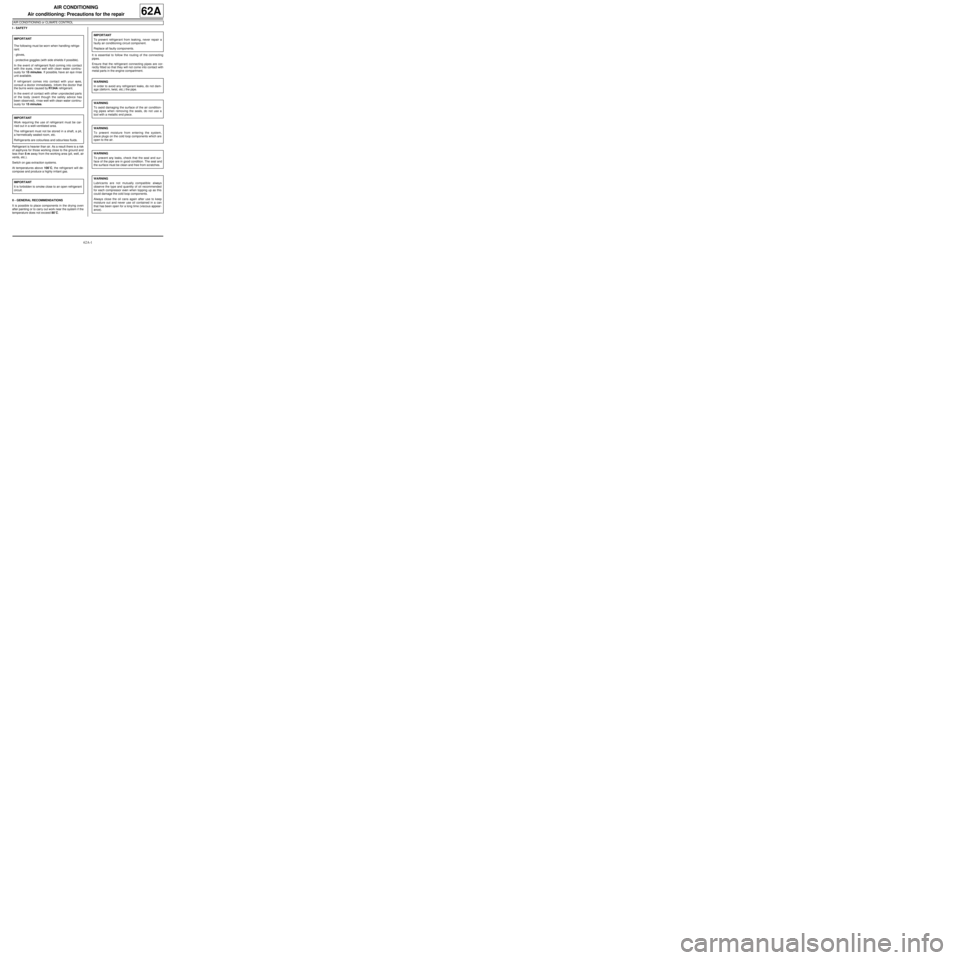
62A-1
AIR CONDITIONING
Air conditioning: Precautions for the repair
AIR CONDITIONING or CLIMATE CONTROL
62A
I - SAFETY
Refrigerant is heavier than air. As a result there is a risk
of asphyxia for those working close to the ground and
less than 5 m away from the working area (pit, well, air
vents, etc.).
Switch on gas extraction systems.
At temperatures above 100˚C, the refrigerant will de-
compose and produce a highly irritant gas.
II - GENERAL RECOMMENDATIONS
It is possible to place components in the drying oven
after painting or to carry out work near the system if the
temperature does not exceed 80˚C.It is essential to follow the routing of the connecting
pipes.
Ensure that the refrigerant connecting pipes are cor-
rectly fitted so that they will not come into contact with
metal parts in the engine compartment. IMPORTANT
The following must be worn when handling refrige-
rant:
-gloves,
-protective goggles (with side shields if possible).
In the event of refrigerant fluid coming into contact
with the eyes, rinse well with clean water continu-
ously for 15 minutes. If possible, have an eye rinse
unit available.
If refr igerant comes into contact with your eyes,
consult a doctor immediately. Inform the doctor that
the burns were caused by R134A refrigerant.
In the event of contact with other unprotected parts
of the body (event though the safety advice has
been observed), r inse well with clean water continu-
ously for 15 minutes.
IMPORTANT
Work requiring the use of refrigerant must be car-
ried out in a well-ventilated area.
The refrigerant must not be stored in a shaft, a pit,
a hermetically sealed room, etc.
Refrigerants are colourless and odourless fluids.
IMPORTANT
It is forbidden to smoke close to an open refrigerant
circuit.
IMPORTANT
To prevent refrigerant from leaking, never repair a
faulty air conditioning circuit component.
Replace all faulty components.
WARNING
In order to avoid any refrigerant leaks, do not dam-
age (deform, twist, etc.) the pipe.
WARNING
To avoid damaging the surface of the air condition-
ing pipes when removing the seals, do not use a
tool with a metallic end piece.
WARNING
To prevent moisture from entering the system,
place plugs on the cold loop components which are
open to the air.
WARNING
To prevent any leaks, check that the seal and sur-
face of the pipe are in good condition. The seal and
the surface must be clean and free from scratches.
WARNING
Lubricants are not mutually compatible: always
observe the type and quantity of oil recommended
for each compressor even when topping up as this
could damage the cold loop components.
Always close the oil cans again after use to keep
moisture out and never use oil contained in a can
that has been open for a long time (viscous appear-
ance).
Page 83 of 122
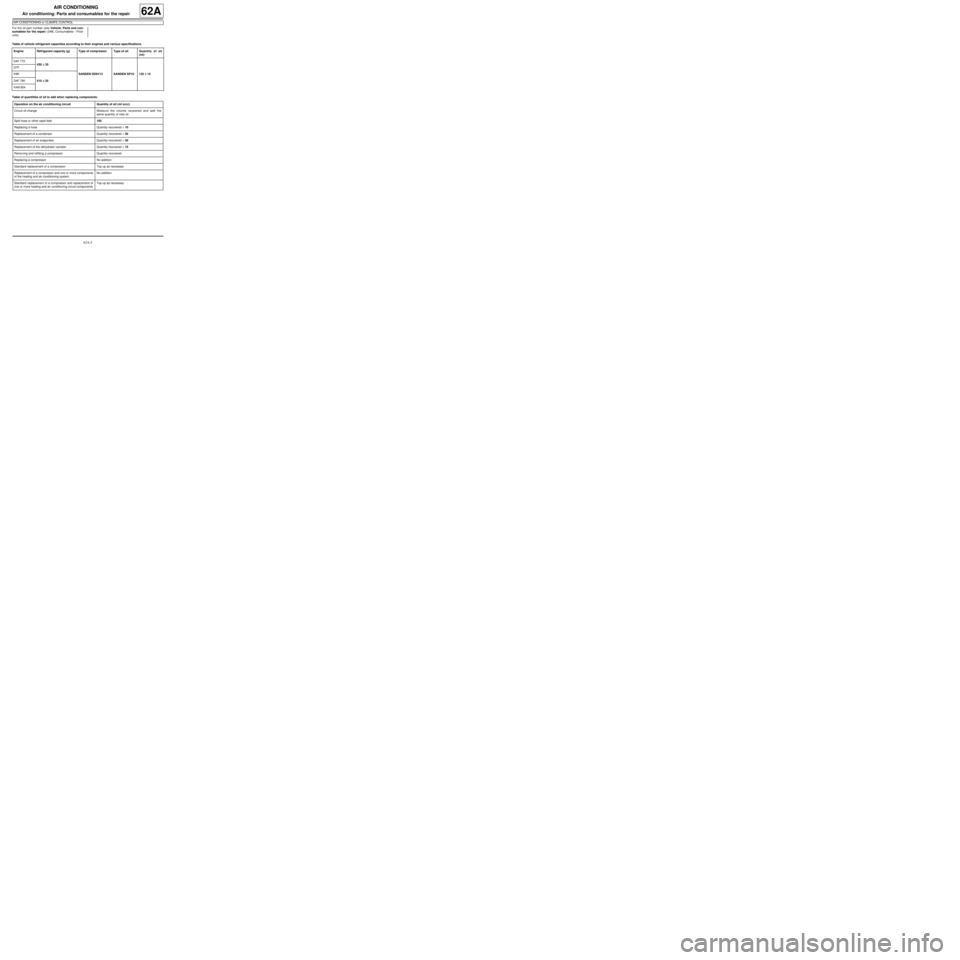
62A-2
AIR CONDITIONING
Air conditioning: Parts and consumables for the repair
AIR CONDITIONING or CLIMATE CONTROL
62A
For the oil part number (see Vehicle: Parts and con-
sumables for the repair) (04B, Consumables - Prod-
ucts).
Table of vehicle refrigerant capacities according to their engines and various specifications.
Table of quantities of oil to add when replacing components:Engine Refrigerant capacity (g) Type of compressor Type of oilQuantity of oil
(ml)
D4F 772
430 ±± ± ±
35
SANDEN SD6V12 SANDEN SP10 135 ±± ± ±
10 D7F
K9K
510 ±± ± ±
35 D4F 780
K4M 854
Operation on the air conditioning circuit Quantity of oil (ml orcc)
Circuit oil changeMeasure the volume recovered and add the
same quantity of new oil
Split hose or other rapid leak100
Replacing a hose Quantity recovered + 10
Replacement of a condenser Quantity recovered + 30
Replacement of an evaporator Quantity recovered + 30
Replacement of the dehydrator canister Quantity recovered + 15
Removing and refitting a compressor Quantity recovered
Replacing a compressor No addition
Standard replacement of a compressor Top up as necessary
Replacement of a compressor and one or more components
of the heating and air conditioning systemNo addition
Standard replacement of a compressor and replacement of
one or more heating and air conditioning circuit componentsTop up as necessary
Page 84 of 122
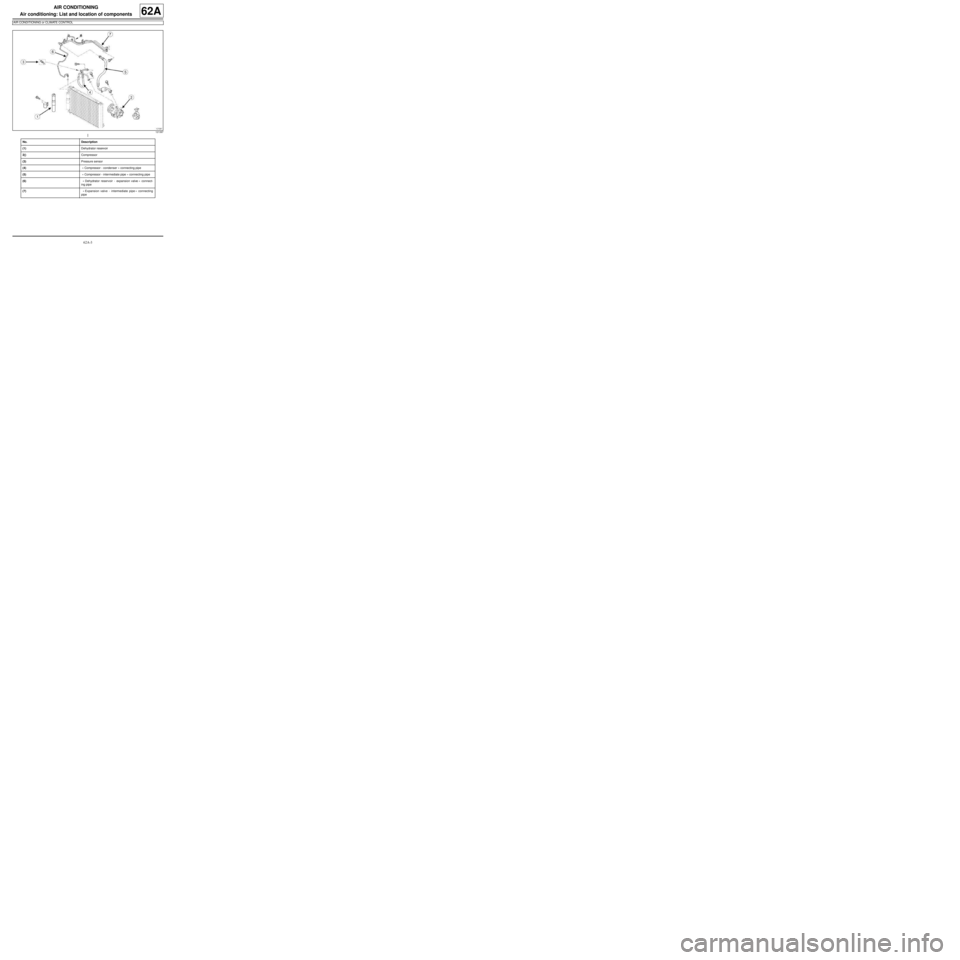
62A-3
AIR CONDITIONING
Air conditioning: List and location of components
AIR CONDITIONING or CLIMATE CONTROL
62A
121397
No. Description
(1)Dehydrator reservoir
2()Compressor
(3)Pressure sensor
(4) « Compressor - condenser » connecting pipe
(5) « Compressor - intermediate pipe » connecting pipe
(6) « Dehydrator reservoir - expansion valve » connect-
ing pipe
(7) « Expansion valve - intermediate pipe » connecting
pipe
Page 85 of 122
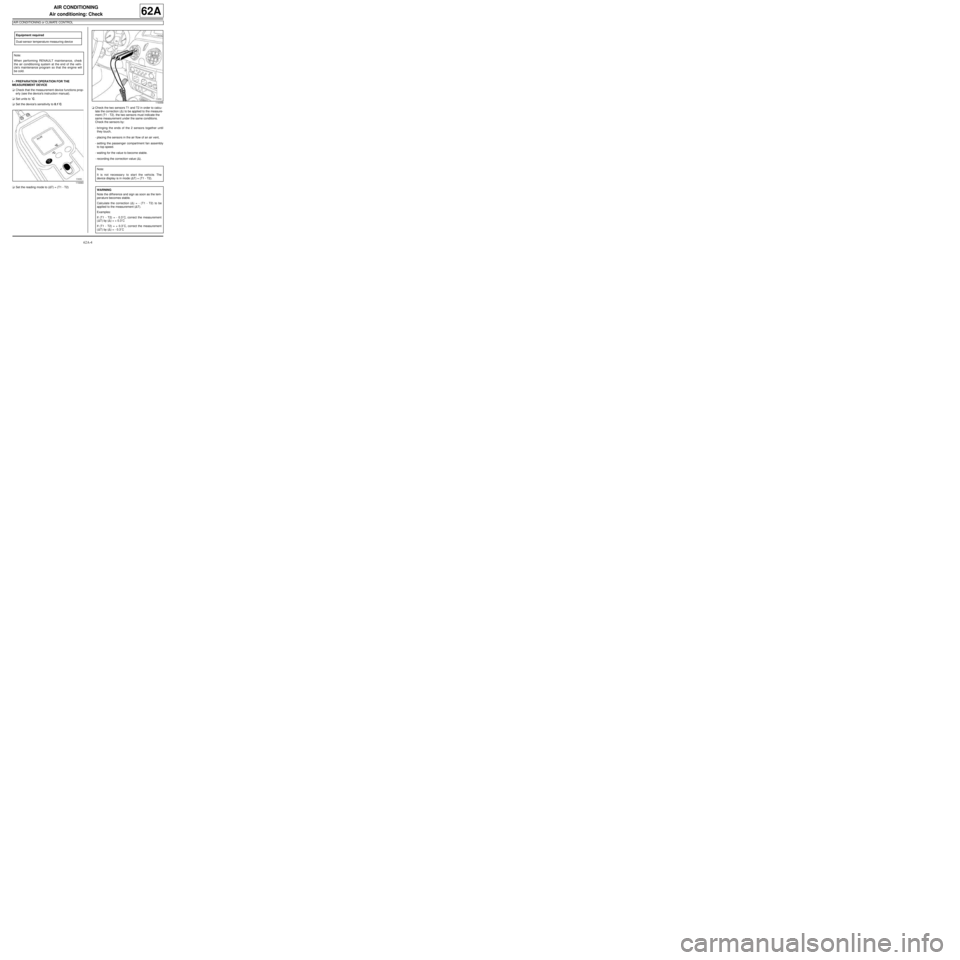
62A-4
AIR CONDITIONING
Air conditioning: Check
AIR CONDITIONING or CLIMATE CONTROL
62A
I - PREPARATION OPERATION FOR THE
MEASUREMENT DEVICE
aCheck that the measurement device functions prop-
erly (see the device's instruction manual).
aSet units to ˚C.
aSet the device's sensitivity to 0.1˚C.
aSet the reading mode to (∆T) = (T1 - T2)aCheck the two sensors T1 and T2 in order to calcu-
late the correction (∆) to be applied to the measure-
ment (T1 - T2). the two sensors must indicate the
same measurement under the same conditions.
Check the sensors by:
-bringing the ends of the 2 sensors together until
they touch,
-placing the sensors in the air flow of an air vent,
-setting the passenger compartment fan assembly
to top speed.
-waiting for the value to become stable.
-recording the correction value (∆). Equipment required
Dual-sensor temperature measuring device
Note:
When performing RENAULT maintenance, check
the air conditioning system at the end of the vehi-
cle's maintenance program so that the engine will
be cold.
119360
119358
Note:
It is not necessary to start the vehicle. The
device display is in mode (∆T) = (T1 - T2).
WARNING
Note the diff erence and sign as soon as the tem-
per ature becomes stable.
Calculate the correction (∆) = - (T1 - T2) to be
applied to the measurement (∆T).
Examples:
If (T1 - T2) = - 0.3˚C, correct the measurement
(∆T) by (∆) = + 0.3˚C
If (T1 - T2) = + 0.3˚C, correct the measurement
(∆T) by (∆) = - 0.3˚C
Page 86 of 122
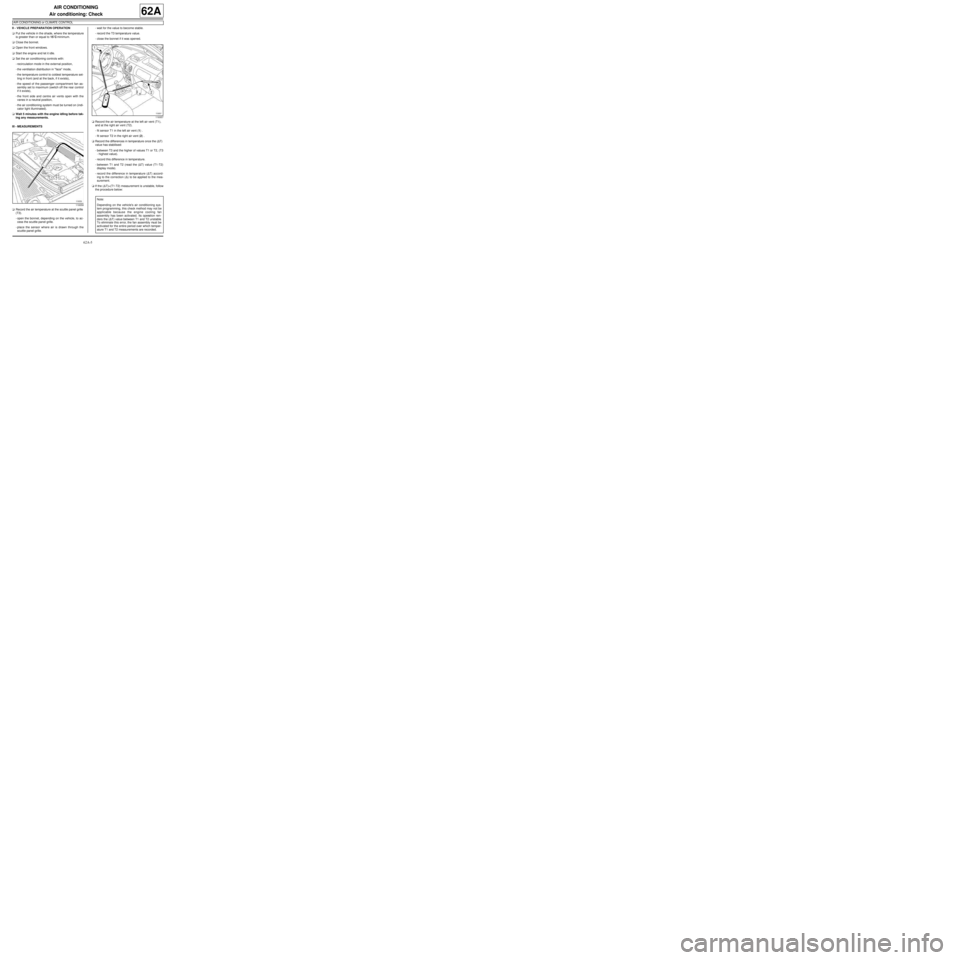
62A-5
AIR CONDITIONING
Air conditioning: Check
AIR CONDITIONING or CLIMATE CONTROL
62A
II - VEHICLE PREPARATION OPERATION
aPut the vehicle in the shade, where the temperature
is greater than or equal to 15˚C minimum.
aClose the bonnet.
aOpen the front windows.
aStart the engine and let it idle.
aSet the air conditioning controls with:
-recirculation mode in the external position,
-the ventilation distribution in "face" mode,
-the temperature control to coldest temperature set-
ting in front (and at the back, if it exists),
-the speed of the passenger compartment fan as-
sembly set to maximum (switch off the rear control
if it exists),
-the front side and centre air vents open with the
vanes in a neutral position,
-the air conditioning system must be turned on (indi-
cator light illuminated).
aWait 5 minutes with the engine idling before tak-
ing any measurements.
III - MEASUREMENTS
aRecord the air temperature at the scuttle panel grille
(T3).
-open the bonnet, depending on the vehicle, to ac-
cess the scuttle panel grille.
-place the sensor where air is drawn through the
scuttle panel grille.-wait for the value to become stable.
-record the T3 temperature value.
-close the bonnet if it was opened.
aRecord the air temperature at the left air vent (T1),
and at the right air vent (T2).
-fit sensor T1 in the left air vent (1) .
-fit sensor T2 in the right air vent (2) .
aRecord the differences in temperature once the (∆T)
value has stabilised:
-between T3 and the higher of values T1 or T2, (T3
- highest value).
-record this difference in temperature.
-between T1 and T2 (read the (∆T) value (T1-T2)
display mode).
-record the difference in temperature (∆T) accord-
ing to the correction (∆) to be applied to the mea-
surement.
aIf the (∆T)=(T1-T2) measurement is unstable, follow
the procedure below:
119359
119357
Note:
Depending on the vehicle's air conditioning sys-
tem programming, this check method may not be
applicable because the engine cooling fan
assembly has been activated. Its operation ren-
ders the (∆Τ) value between T1 and T2 unstable.
To eliminate this error, the fan assembly must be
activated for the entire period over which temper-
ature T1 and T2 measurements are recorded.
Page 87 of 122
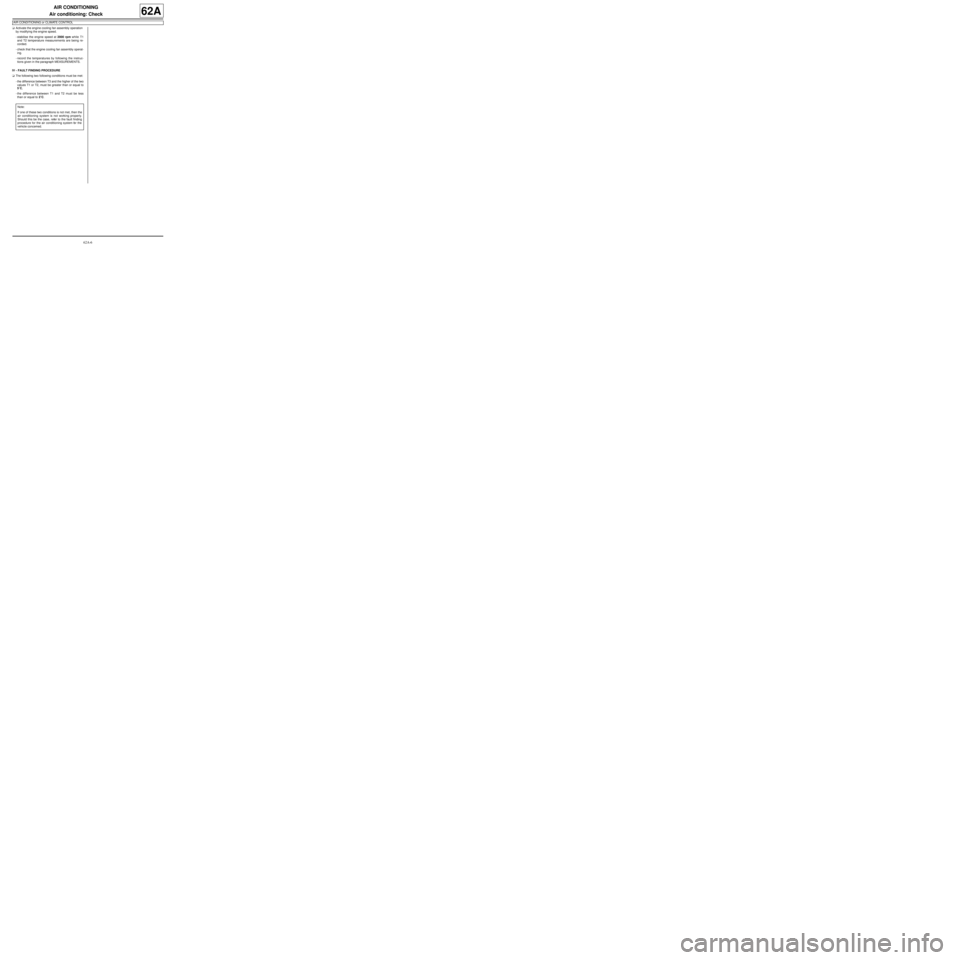
62A-6
AIR CONDITIONING
Air conditioning: Check
AIR CONDITIONING or CLIMATE CONTROL
62A
aActivate the engine cooling fan assembly operation
by modifying the engine speed.
-stabilise the engine speed at 2000 rpm while T1
and T2 temperature measurements are being re-
corded.
-check that the engine cooling fan assembly operat-
ing.
-record the temperatures by following the instruc-
tions given in the paragraph MEASUREMENTS.
IV - FAULT FINDING PROCEDURE
aThe following two following conditions must be met:
-the difference between T3 and the higher of the two
values T1 or T2, must be greater than or equal to
5˚C,
-the difference between T1 and T2 must be less
than or equal to 2˚C.
Note:
If one of these two conditions is not met, then the
air conditioning system is not working properly.
Should this be the case, refer to the fault finding
procedure for the air conditioning system for the
vehicle concerned.
Page 88 of 122
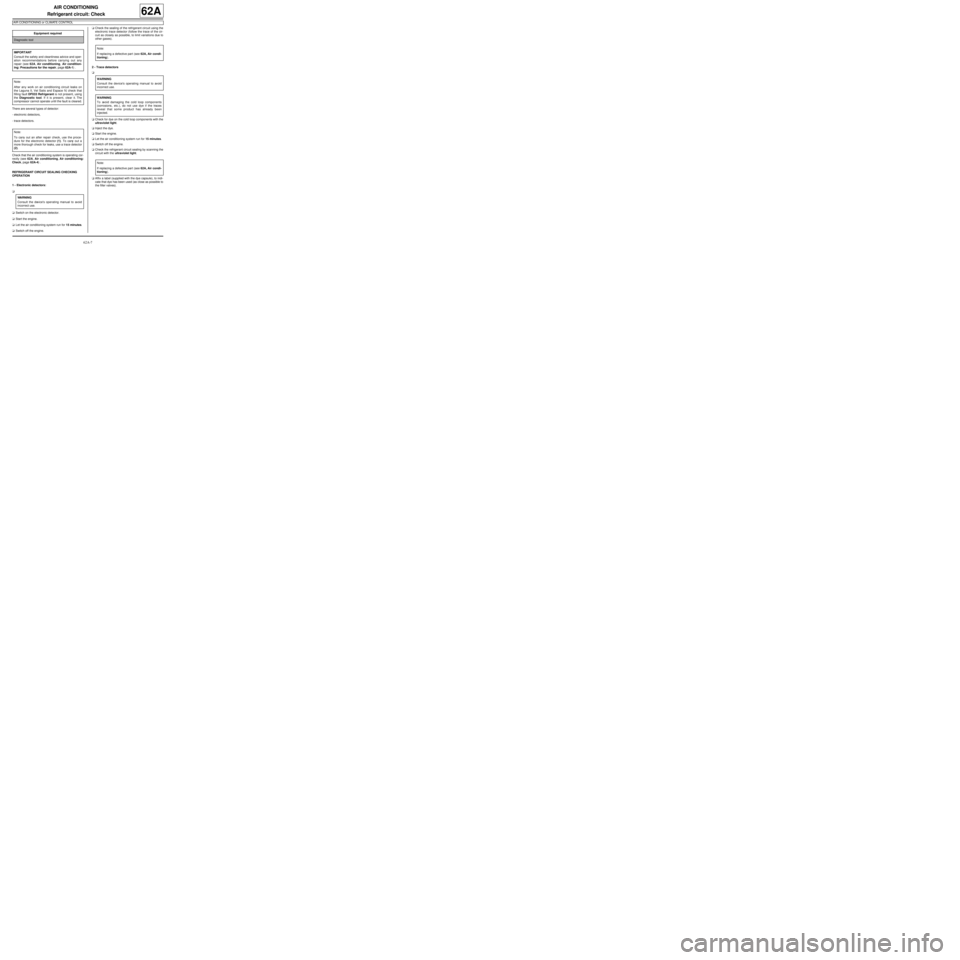
62A-7
AIR CONDITIONING
Refrigerant circuit: Check
AIR CONDITIONING or CLIMATE CONTROL
62A
There are several types of detector:
-electronic detectors,
-trace detectors.
Check that the air conditioning system is operating cor-
rectly (see 62A, Air conditioning, Air conditioning:
Check, page 62A-4) .
REFRIGERANT CIRCUIT SEALING CHECKING
OPERATION
1 - Electronic detectors:
a
aSwitch on the electronic detector.
aStart the engine.
aLet the air conditioning system run for 15 minutes.
aSwitch off the engine.aCheck the sealing of the refrigerant circuit using the
electronic trace detector (follow the trace of the cir-
cuit as closely as possible, to limit variations due to
other gases).
2 - Trace detectors
a
aCheck for dye on the cold loop components with the
ultraviolet light.
aInject the dye.
aStart the engine.
aLet the air conditioning system run for 15 minutes.
aSwitch off the engine.
aCheck the refrigerant circuit sealing by scanning the
circuit with the ultraviolet light.
aAffix a label (supplied with the dye capsule), to indi-
cate that dye has been used (as close as possible to
the filler valves). Equipment required
Diagnostic tool
IMPORTANT
Consult the safety and cleanliness advice and oper-
ation recommendations before carrying out any
repair (see 62A, Air conditioning, Air condition-
ing: Precautions for the repair, page 62A-1) .
Note:
After any work on air conditioning circuit leaks on
the Laguna II, Vel Satis and Espace IV, check that
filling fault DF033 Refrigerant is not present, using
the Diagnostic tool. If it is present, clear it. The
compressor cannot operate until the fault is cleared.
Note:
To carry out an after repair check, use the proce-
dure for the electronic detector (1). To carry out a
more thorough check for leaks, use a trace detector
(2).
WARNING
Consult the device's operating manual to avoid
incorrect use.
Note:
If replacing a defective part (see 62A, Air condi-
tioning).
WARNING
Consult the device's operating manual to avoid
incorrect use.
WARNING
To avoid damaging the cold loop components
(corrosions , etc.), do not use dye if the traces
reveal that some product has already been
injected.
Note:
If replacing a defective part (see 62A, Air condi-
tioning).
Page 89 of 122
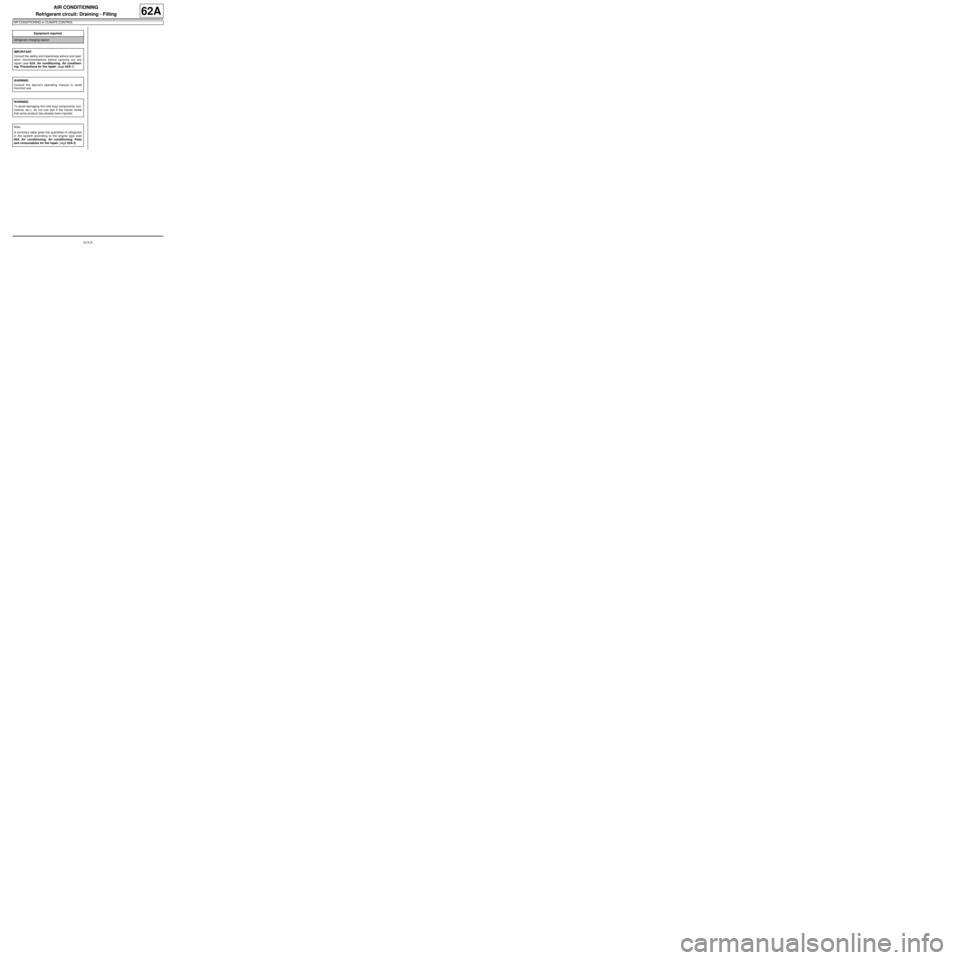
62A-8
AIR CONDITIONING
Refrigerant circuit: Draining - Filling
AIR CONDITIONING or CLIMATE CONTROL
62A
Equipment required
refrigerant charging station
IMPORTANT
Consult the safety and cleanliness advice and oper-
ation recommendations before carrying out any
repair (see 62A, Air conditioning, Air condition-
ing: Precautions for the repair, page 62A-1) .
WARNING
Consult the device's operating manual to avoid
incorrect use.
WARNING
To avoid damaging the cold loop components (cor-
rosions, etc.), do not use dye if the traces reveal
that some product has already been injected.
Note:
A summary table gives the quantities of refrigerant
in the system according to the engine type (see
62A, Air conditioning, Air conditioning: Parts
and consumables for the repair, page 62A-2) .
Page 90 of 122
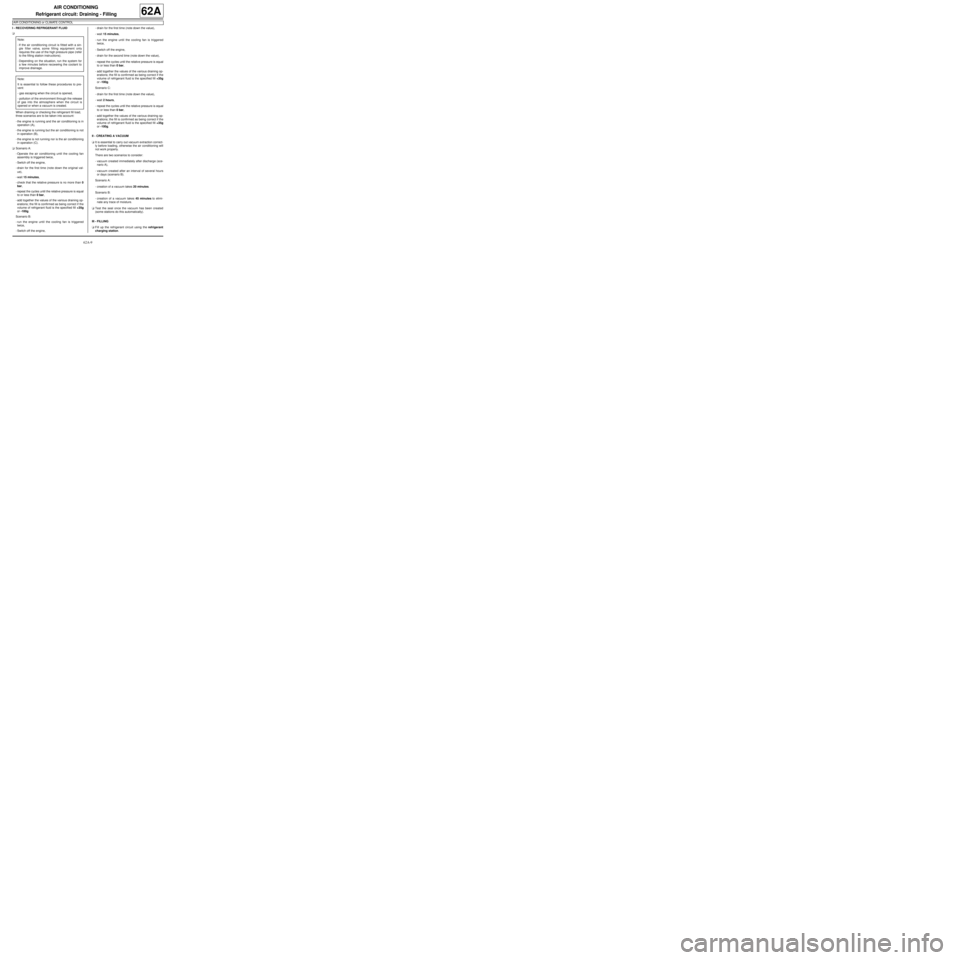
62A-9
AIR CONDITIONING
Refrigerant circuit: Draining - Filling
AIR CONDITIONING or CLIMATE CONTROL
62A
I - RECOVERING REFRIGERANT FLUID
a
When draining or checking the refrigerant fill load,
three scenarios are to be taken into account:
-the engine is running and the air conditioning is in
operation (A),
-the engine is running but the air conditioning is not
in operation (B),
-the engine is not running nor is the air conditioning
in operation (C).
aScenario A:
-Operate the air conditioning until the cooling fan
assembly is triggered twice,
-Switch off the engine,
-drain for the first time (note down the original val-
ue),
-wait 15 minutes,
-check that the relative pressure is no more than 0
bar,
-repeat the cycles until the relative pressure is equal
to or less than 0 bar,
-add together the values of the various draining op-
erations; the fill is confirmed as being correct if the
volume of refrigerant fluid is the specified fill +35g
or -100g.
Scenario B:
-run the engine until the cooling fan is triggered
twice,
-Switch off the engine,-drain for the first time (note down the value),
-wait 15 minutes,
-run the engine until the cooling fan is triggered
twice,
-Switch off the engine,
-drain for the second time (note down the value),
-repeat the cycles until the relative pressure is equal
to or less than 0 bar,
-add together the values of the various draining op-
erations; the fill is confirmed as being correct if the
volume of refrigerant fluid is the specified fill +35g
or -100g.
Scenario C:
-drain for the first time (note down the value),
-wait 2 hours,
-repeat the cycles until the relative pressure is equal
to or less than 0 bar,
-add together the values of the various draining op-
erations; the fill is confirmed as being correct if the
volume of refrigerant fluid is the specified fill +35g
or -100g.
II - CREATING A VACUUM
aIt is essential to carry out vacuum extraction correct-
ly before loading, otherwise the air conditioning will
not work properly.
There are two scenarios to consider:
-vacuum created immediately after discharge (sce-
nario A),
-vacuum created after an interval of several hours
or days (scenario B).
Scenario A:
-creation of a vacuum takes 20 minutes.
Scenario B:
-creation of a vacuum takes 45 minutes to elimi-
nate any trace of moisture.
aTest the seal once the vacuum has been created
(some stations do this automatically).
III - FILLING
aFill up the refrigerant circuit using the refrigerant
charging station. Note:
-If the air conditioning circuit is fitted with a sin-
gle filler valve, some filling equipment only
requires the use of the high pressure pipe (refer
to the filling station instructions).
-Depending on the situation, run the system for
a few minutes before recovering the coolant to
improve drainage.
Note:
It is essential to follow these procedures to pre-
vent:
- gas escaping when the circuit is opened,
- pollution of the environment through the release
of gas into the atmosphere when the circuit is
opened or when a vacuum is created.